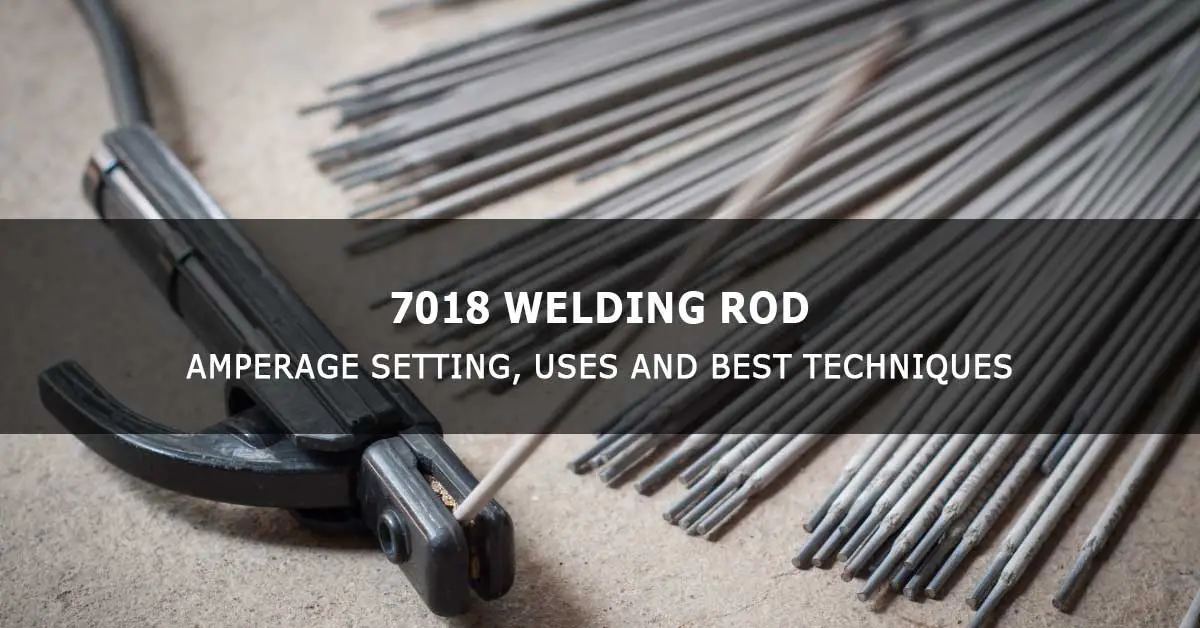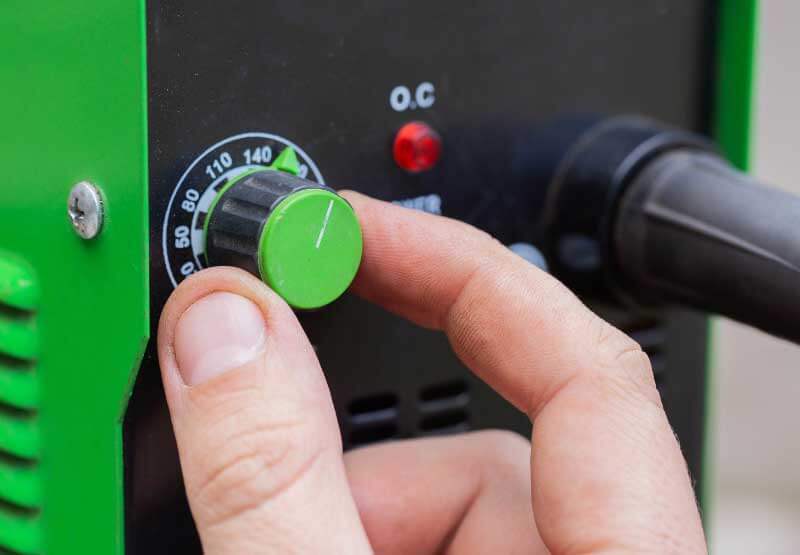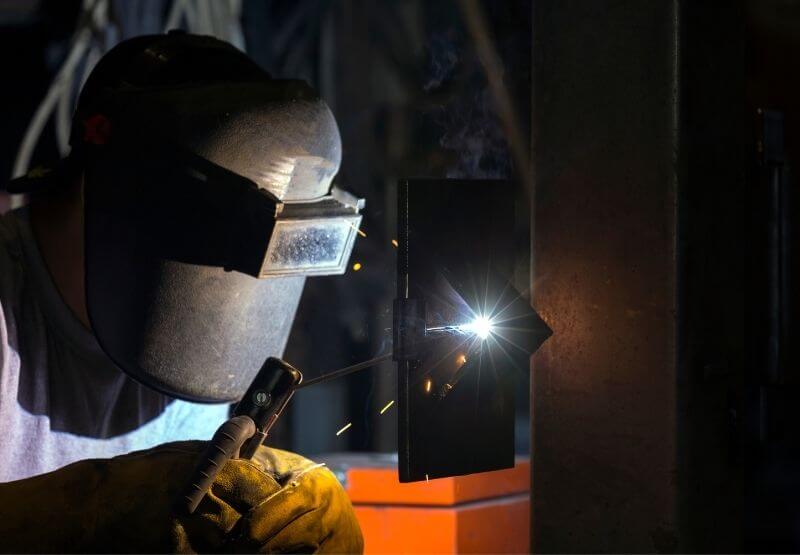If you are looking for a reliable and strong welding rod to help complete your next big project, 7018 welding rods are perfect. These low hydrogen electrodes have been used in structural welding projects like steel bridges, building construction, pipe fabrication, and more making them one of the most trusted welding rods amongst welders for completing even the toughest jobs.
In this article, we will walk through everything you need to know about 7018 welding rods: from amperage settings and proper use techniques to some of the best ways to get the job done precisely. So strap on your helmet, and let’s dive into what makes 7018 rods great!
Brief about 7018 welding electrode
The code of the E7018 stick welding electrode means the following, as per the American Welding Society standard:
E-Electrode for shielded metal arc welding (SMAW) or stick welding process
70– Indicates the minimum ultimate tensile as 70,000 psi. (Minimum yield strength is 58,000 psi. The elongation percentage is 22 %.)
1-Indicates this is an all-position welding rod that can be used for welding in horizontal, vertical, overhead, and flat positions.
8-This refers to the coating type ‘Low hydrogen potassium, iron powder,’ which can be used with the current DCEP (DC reverse polarity) and AC.
The E 7018 rod may have an additional code at the end. E 7018 H4 or E 7018 H8, E7018-1, and E 7018-R.
E 7018 H4 or E 7018 H8: These designators refer to the amount of diffusible Hydrogen the stick electrode deposits in the weld. H4 indicates the weld deposit has ≤ 4 ml of diffusible Hydrogen per 100 grams of weld metal, which is 8 ml of diffusible Hydrogen at 100 grams for H8.
E 7018-1: 1 implies the electrode provides better weld-metal toughness and impact properties.
E 7018-R: R implies that the electrode has undergone actual tests and that the electrode manufacturer has considered the electrode to be resistant to moisture (the test conducted ensures “the electrode should be able to resist the moisture (within a given limit) after it was exposed to a temperature of 80° F and 80% relative humidity for 9 hours”).
Chemical Composition of welding electrode E 7018
| Chemical properties of E 7018 | ||
| Carbon-0.15% max | Chromium-0.2% max | Manganese-1.6% max |
| Molybeenum-0.3% max | Nickel-0.3% max | Phosphorous-0.035% max |
| Silicon-0.75% max | Sulfur-0.035% max | Vanadium-0.08% max |
Few parameters for E7018 stick welding electrodes
| Few parameters for E7018 stick welding electrodes | ||
| Welding rod diameter in inches | Type of power | Amperage range |
| 3/32ʺ | DCEP or AC | 70-110 |
| 1/8ʺ | DCEP or AC | 90-160 |
| 5/32ʺ | DCEP or AC | 110-230 |
| 3/16ʺ | DCEP or AC | 190-300 |
| 7/32ʺ | DCEP or AC | 240-340 |
| 1/4ʺ | DCEP or AC | 310-390 |
7018 is a versatile and low-hydrogen electrode for welding mild steel and low and medium-carbon steel. The low hydrogen content in the coating allows a minimal quantity of Hydrogen into the molten weld puddle and helps minimize the welding cracks.
The characteristics of the 7018 electrodes are:
- 7018 rod has low-hydrogen iron powder in its coating and gives good weld deposition rates, and the weld bead needs minimum post-weld cleaning. These qualities improve welding productivity.
- 7018 is a user-friendly, all-position electrode with a medium penetration level and a high deposition rate, allowing you to add more filler metal into the weld quickly.
- The E7018 stick welding electrode produces good weld beads with minimum splatter. The slag is heavier but can be removed easily. 7018 produces beautiful smooth weld beads with well-defined ripples.
- 7018 rod can be used for all position welds and works with DCEP (DC reverse polarity) and AC.
- Due to the 7018 welding rod being a low hydrogen rod, it requires strict storage, and it is mandatory to use a drying oven. The E7018 stick welding electrode should be dried in an oven at 500° F and stored in the oven or a cabinet maintained at 250° F-300° F.
- When damp, a 7018 hydrogen rod will produce a weak and porous weld, and an oven-dried rod ensures a low hydrogen weld metal deposit.
- 7018 rod has the mechanical properties (like minimum tensile strength) required for the structural welds, and it has the advantage of smooth and stable arc and minimal spatter levels.
- The deoxidizers present in the coating enable the E7018 stick hydrogen rod to withstand some contaminants common in structural steel; however, wherever possible, the welding area should be cleaned before welding, eliminating many welding defects.
- 7018 rods are easy to strike and re-strike the arc. However, many WPS (welding procedure specifications) may not allow re-striking of the arc during welding.
- 7018 rod is trusted for structural welds and is used in metal fabrications in building construction, steel structure fabrication, power plants, bridges, Pipe welding, welding of pressure vessels and boilers, construction of ship hulls, offshore rigs, and heavy-duty weldments.
- 7018 rod has a thick coating that includes iron powder, and this rod can be effectively used with the drag welding technique (when you drag welding, the stinger “electrode holder” is ahead of the weld puddle. The welding rod at the leading edge drags the molten weld puddle).
- 7018 welding rod is a medium penetration fill-freeze type electrode suitable for welding low and medium-carbon steels with higher tensile strength.
7018 Welding rod amperage setting, uses, & best techniques
Amperage setting
A correct setting of the amperage contributes to a spatter-free good weld bead, and on the other hand, a wrong setting of the amperage can result in a bad and low-quality weld bead with weld defects.
The proper welding amperage for 7018 depends on the welding rod diameter, base metal thickness, the temperature of the base metal, etc. Expert welders give a thumb rule of 30 amperes of current per 1/32ʺ rod, and as per this, the approximate amperage required for a 3/32ʺ mm diameter welding rod is 90 amps.
Every welding rod manufacturer prints the recommended ampere range for the diameter of the 7018 rods packed in the box, and it is a good guide. However, this recommended ampere range can differ from manufacturer to manufacturer.
The suggested ampere range for the welding rods is compiled in a table (please see section II above). You will notice that the suggested ampere range increases with the increase in the diameter of the welding rod (it is obvious that a higher diameter rod needs higher ampere/heat to melt).
The link between the welding rod diameter, base metal thickness, and amperage
For welding thicker base metals, you need higher weld metal deposition, so you must select a welding rod of higher diameter. And a higher-diameter rod needs more amperage to melt it.
In the same way, you have to select a smaller diameter welding rod for welding thin metal sheets, and obviously, the smaller diameter welding rod needs less current to melt it.
The advice of experienced welders is ‘never use a welding rod whose diameter is more than the base metal thickness.’
The following table gives the suggested welding electrode diameter v/s base metal thickness. This data is only for general guidance, and the actual amperage should be set after considering the actual thickness of the base metal, welding position, welding machine used, WPS, etc.
| Sl. no. | Electrode diameter in inches | Metal thickness in inches |
| 01 | 3/32ʺ | 3/32ʺ to 3/16ʺ |
| 02 | 1/8ʺ | 1/8ʺ to 1/4ʺ |
| 03 | 5/32ʺ | 1/4ʺ to 3/8ʺ |
| 04 | 3/16ʺ and 7/32ʺ | More than 3/8ʺ |
The link between the welding rod diameter and amperage when welding in different welding positions
The suggested welding rod diameter for the base metal thickness works well for flat and horizontal position welds.
However, when welding in an overhead position with a higher diameter rod (like 5/32ʺ), you may face the serious problem of manipulating and controlling the molten puddle of weld metal unless you have good experience.
Hence, expert welders suggest using a 1/8ʺ welding rod, setting the amperage sufficient for a tight arc for overhead welding, and increasing the amperage in small increments if necessary. The speed of welding should be just sufficient to avoid undercut defects.
7018 is considered a good electrode for vertical-up welding. Use the amperage at the lower end of the suggested range (for the rod diameter) since it helps faster freezing of the weld metal (using a higher amperage may result in a part of the molten weld metal falling due to gravity).
The link between base metal temperature and amperage
The amperage setting depends on the temperature of the base metal also. The base filler metals are pre and/or post-heated to eliminate welding defects, and the ampere setting for pre-heated base metals will be less than for a base metal at room temperature.
You have referred to all the data and set the ampere for your project. But how can you know if the set amperage is correct or not? Experienced welders will know whether the amperage setting is correct by observing the welding arc, the puddle of weld metal, etc.
Let us discuss the effects of lower or higher amperage settings
Indication of lower amperage setting
- Difficulty in melting the rod.
- Difficulty in striking the arc.
- Difficulty in creating a molten weld puddle that can fuse with the weld joint.
- The welding rod sticks to the base metal.
- Low penetration.
Indication of higher amperage setting
- The welding arc can create an undercut defect on the weld joint, and the molten weld puddle can go out of control.
- The welding rod becomes red hot along its length.
- Wider weld bead.
- Increase in weld spatter
Welding techniques
A good rule of thumb is to maintain a weld bead width equivalent to 2.5 times the core diameter of the electrode for horizontal and flat position welding and 2.5 to 3 times the core diameter for vertical-up welding. If you go for a wider weld bead than this, there can be chances of slag inclusion, and the weld bead needs to look nicer.
Maintain the distance between the electrode tip and the base metal constant to keep the arc length under control. This distance should be continuously monitored since, as the rod burns, the tip moves away from the base metal.
For critical welds, follow the pre or/and post-heat to slow down the cooling rate after welding and give the Hydrogen more time to disperse. This process is to minimize or avoid weld cracks related to Hydrogen.
If you are new to welding, it is always good to do the welding on a trial piece before doing your project.
Conclusion
The 7018 welding rod is an incredibly versatile and reliable electrode that can be used for almost any structural welding project. Its low hydrogen content makes it suitable for various metals, including mild steel, stainless steel, aluminum, and more.
You should adjust your amperage correctly and use the right technique to get the most out of this welding rod. With proper care and attention to detail, your welds will always look strong and reliable!
Start experimenting with 7018 welding rods today to see what projects you can take on!
Continue Reading: A Guide To 6010, 6011, 6013, And 7018 Welding Rods.
References







